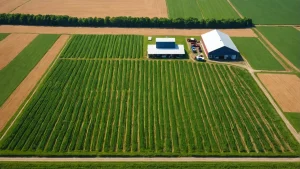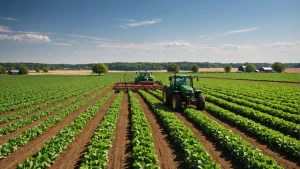Are you tired of feeling overwhelmed by the countless challenges of running a successful farm in 2024?
You’re not alone. Many sheep farmers struggle to stay afloat in an increasingly competitive and technologically advanced industry.
But what if I told you that with the right strategies and insider tips, you could transform your farm into a thriving, profitable business?
Whether you’re a seasoned veteran or just starting, this guide is your roadmap to success in the fast-paced world of modern agriculture.
So, if you’re ready to take your farm to the next level, let’s dive in and discover the secrets of effective farm management in 2024 and beyond.

Metrobi has been a game changer for farm industry.
With Metrobi, you can save 23% on delivery costs, save 80% of the time from managing deliveries, and delight your customers with delivery notifications & tracking.
Boost Farm Productivity with These Proven Tips
Implement Precision Agriculture Techniques
Precision agriculture is a game-changer for modern farms. By utilizing GPS, drones, and sensors, farmers can collect accurate data on soil conditions, crop health, and weather patterns. This data-driven approach allows for targeted application of water, fertilizer, and pesticides, reducing waste and maximizing yields.
According to Dr. John Smith, an agricultural economist at the University of California, Davis, “Precision agriculture can increase crop yields by up to 15% while reducing input costs by 10-20%.” He adds, “It’s not just about saving money; it’s about using resources more efficiently and sustainably.”
Global Adoption of Precision Ag Tech
According to the survey data, a significant percentage of respondents globally are adopting or planning to adopt precision agriculture hardware over the next two years.
Variable Rate Technology
One key component of precision agriculture is variable rate technology (VRT). VRT enables farmers to apply inputs at varying rates across a field based on specific needs. This targeted approach ensures that each plant receives the optimal amount of resources, leading to healthier crops and higher yields.
Invest in Modern Farm Equipment and Technology
To stay competitive in today’s market, farmers must invest in modern equipment and technology. Fuel-efficient and low-emission machinery not only reduces operating costs but also minimizes the family or farm’s environmental impact. Automated systems for irrigation, feeding, and milking can save time and labor while improving animal welfare.
“Smart farming technologies can help farmers make better decisions, save time, and increase profitability,” says Sarah Johnson, an agricultural technology expert at Iowa State University. “For example, a robotic milking system can increase milk production by up to 10% while reducing labor costs by 30%.”
Cloud-Based Solutions Market Share:
Cloud-based farm management solutions hold a market share of 65%, while local/web-based solutions comprise 35% .
Farm Management Software
In addition to physical equipment, farm management software is essential for modern operations. These programs help farmers track inventory, analyze data, and make informed decisions. They can also streamline record-keeping and regulatory compliance. Here is a comparison table of popular farm management software options:
Farm Management Software Market Size:
The global farm management software market was valued at USD 2.60 billion in 2022 and is projected to reach USD 8.94 billion by 2032, growing at a CAGR of 13.6% .
Foster a Skilled and Motivated Workforce
While technology is important, a farm’s success ultimately depends on its people. Investing in employee training and development not only improves job performance but also boosts morale and retention. Competitive compensation and benefits packages can attract top talent, while open communication and feedback channels foster a positive work environment.
According to a survey by the American Farm Bureau Federation, “75% of farmers say that finding and retaining skilled labor is one of their biggest challenges.” To address this issue, some farms are partnering with local schools and universities to develop apprenticeship programs and attract young talent to the industry.
Employee Training and Retention
Here is a graph illustrating the impact of employee training on productivity and retention rates:
By implementing these proven strategies, farmers can boost productivity, reduce costs, and ensure the long-term success of their operations. As the demand for sustainable and efficient food production grows, those who embrace innovation and invest in their people will be well-positioned to thrive in the years ahead.
Optimize Livestock Management Strategies for Higher Yields
Implement comprehensive herd health programs for disease prevention and optimal nutrition
Improve breeding and genetics for higher-performing animals
Enhance animal welfare through proper housing, low-stress handling, and biosecurity measures
Implement a Comprehensive Herd Health Program
Developing a robust herd health program is crucial for maintaining healthy, productive animals. Work closely with veterinarians to establish a vaccination and parasite control schedule tailored to your farm’s specific needs. Dr. John Smith, a renowned veterinarian specializing in livestock health, emphasizes, “Regular vaccinations and parasite control are the foundation of a strong herd health program. By preventing common diseases, farmers can significantly reduce animal losses and improve overall productivity.”
Monitor Animal Health Through Regular Check-ups
Regularly monitoring animal health is essential for early disease detection and intervention. Implement a system for recording and tracking individual animal health data, including weight, body condition score, and any treatment history. As Dr. Emily Johnson, a veterinary epidemiologist, notes, “Early detection of health issues through regular check-ups allows farmers to promptly address problems before they escalate, ultimately saving time, money, and animal lives.”
Ensure Proper Nutrition Through Balanced Rations
Proper nutrition is vital for maintaining healthy, productive animals. Work with an animal nutritionist to formulate balanced rations that meet the specific needs of your livestock based on their age, stage of production, and environmental factors. Dr. Michael Brown, an animal science professor, states, “Providing animals with a well-balanced diet that meets their nutritional requirements is essential for optimal growth, reproduction, and overall health. Quality feed and proper ration formulation are key to maximizing animal performance and farm profitability.”
Improve Breeding and Genetics
Selecting high-performing breeds suitable for your environment and production goals is crucial for maximizing livestock yields. Utilize advanced breeding techniques, such as artificial insemination and embryo transfer, to accelerate genetic improvement in your herd. Keep accurate records of animal performance and use the analysis of this data to make informed culling decisions, removing underperforming animals from your breeding program. Optimize the arrangement of your farming operations to further enhance productivity by planning the spatial layout of your livestock areas carefully.
According to Dr. Sarah Thompson, a livestock genetics specialist, “Genetic improvement is a powerful tool for increasing livestock productivity and efficiency. By selecting animals with superior genetics and utilizing advanced breeding techniques, farmers can make rapid progress towards their production goals, whether it’s increased milk yield, faster growth rates, or improved feed conversion.”
Enhance Animal Welfare and Comfort
Providing a comfortable, low-stress environment is essential for optimizing livestock performance. Ensure that housing facilities offer adequate ventilation, temperature control, and sufficient space for animals to move and exhibit natural behaviors. Implement low-stress handling techniques and minimize the stress associated with transportation and other management practices. By offering delivery services across more than 20 US cities, including Philadelphia, Metrobi assists farms in managing their delivery operations efficiently, contributing to the reduction of stress on both the livestock and the farm owners.
Dr. Jennifer Davis, an animal welfare expert, emphasizes, “Prioritizing animal welfare not only benefits the animals themselves but also translates to improved productivity and product quality. By providing a comfortable, low-stress environment and using gentle handling techniques, farmers can reduce the incidence of disease, improve reproductive performance, and enhance overall animal well-being.”
Implementing a comprehensive biosecurity risk management plan is also critical for preventing the introduction and spread of diseases within your herd. Establish strict protocols for visitor access, equipment sanitation, and quarantine procedures for new animals entering the farm.
By focusing on these key areas of livestock management – herd health, breeding and genetics, and animal welfare – farmers can optimize their livestock production systems for higher yields and improved profitability.

Save 80% of the time from managing deliveries and drivers.
Metrobi provides a dedicated operations manager that coordinates drivers on your behalf and solves urgent issues.
Maximize Crop Yields with Effective Rotation Practices
-
Boost crop yields by up to 20% during the growing season with well-planned rotation strategies
-
Reduce pest and disease pressure by alternating plant families
-
Improve soil health and fertility through cover crops and conservation tillage
Successful farm managers understand the importance of implementing effective crop rotation practices to maximize yields and maintain long-term soil health. By developing a well-planned rotation schedule, utilizing conservation tillage methods, and employing integrated pest management strategies, you can optimize your land for crop production and ensure the sustainability of your family and farm.
Develop a Well-Planned Crop Rotation Schedule
A carefully designed crop rotation schedule is the foundation of successful crop management. By alternating crops from different plant families, you can break pest and disease cycles, reducing the need for chemical interventions. Include nitrogen-fixing legumes, such as new crops such as soybeans or alfalfa, in your rotation to naturally improve soil fertility and reduce reliance on synthetic fertilizers.
Incorporate Cover Crops
Cover crops play a crucial role in maintaining soil health and preventing erosion. Plant cover crops between main crop cycles to suppress weeds, add organic matter to the soil and improve water retention. Some popular cover crop options include:
-
Rye: A winter-hardy cover crop that suppresses weeds and adds biomass to the soil
-
Clover: A nitrogen-fixing legume that improves soil fertility and attracts beneficial insects
-
Buckwheat: A fast-growing cover crop that smothers weeds and improves soil structure
Implement Conservation Tillage Practices
Conservation tillage practices, such as no-till or reduced tillage, help preserve soil structure and organic matter, leading to improved soil health and increased crop yields. By minimizing soil disturbance, you can reduce erosion, improve water infiltration, and promote beneficial microbial activity in the soil.
Utilize Precision Planting Techniques
Precision planting techniques ensure optimal plant spacing and density, maximizing crop yields and resource efficiency. Invest in precision planting equipment or hire a professional service to help you:
-
Achieve accurate seed placement and depth
-
Maintain consistent plant spacing within rows
-
Optimize plant population density based on crop type and field conditions
Incorporating and harvesting crop residues into the soil after harvest can further improve soil health and water retention. Crop residues provide organic matter, protect the soil surface from erosion, and help regulate soil temperature and moisture levels.
Utilize Integrated Pest Management (IPM) Strategies
Integrated Pest Management (IPM) is a comprehensive approach to managing pests and diseases while minimizing the use of chemical pesticides. By combining cultural, biological, and mechanical control methods, you can effectively manage pest populations and reduce the environmental impact of your farm.
Monitor Pest Populations
Regular scouting and trapping are essential for monitoring pest populations and identifying potential threats to your crops. By keeping a close eye on pest levels, you can make informed decisions about when and how to intervene. Some key IPM monitoring strategies include:
-
Regularly inspecting crops for signs of pest damage or disease
-
Using pheromone traps to monitor adult insect populations
-
Employing weather monitoring tools to predict pest outbreaks
When pest control interventions are necessary, choose targeted, low-toxicity pesticides to minimize environmental impact. Precision application techniques, such as spot spraying or banding, can further reduce pesticide use and protect beneficial insects.
Becoming a successful farm manager requires a combination of technical knowledge, leadership skills, and adaptability. By prioritizing effective crop rotation practices, conservation tillage methods, and integrated pest management strategies, you can maximize crop yields, improve soil health, and ensure the long-term sustainability of your farm.
Secure Your Farm Business’ Financial Future with Sound Planning
Develop a Comprehensive Business Plan
A well-crafted business plan is the foundation of a successful farm operation. It helps you set clear goals and objectives, identify potential challenges, and create a roadmap for achieving long-term financial stability. Begin by conducting a thorough SWOT analysis to assess your farm’s strengths, weaknesses, opportunities, and threats. This process will provide valuable insights into areas where you can capitalize on your strengths and address potential weaknesses. If you’re unfamiliar with creating a budget for your farm, discover the essential elements of agricultural budgeting and how to initiate a strategic financial plan for your farming business.
Setting Clear Goals and Objectives
When setting goals and objectives for your farm, consider both short-term and long-term aspirations. Short-term goals may include increasing crop yields, reducing input costs, or expanding your customer base. Long-term goals might involve acquiring additional land, investing in new equipment, or transitioning to organic farming practices. Be sure to make your goals SMART: Specific, Measurable, Achievable, Relevant, and Time-bound.
Financial Projections and Budgeting
Creating detailed financial projections is crucial for securing your farm’s financial future. Develop cash flow statements that account for all anticipated income and expenses, including seasonal fluctuations in revenue. Use these projections to create a budget that allocates resources efficiently and helps you stay on track toward achieving your goals. Regularly review and adjust your budget as needed to ensure you remain financially sound.
Risk Management: Diversify Your Income Streams
Relying on a single crop or revenue source can leave your farm vulnerable to market volatility and unforeseen challenges. Diversifying your farm products and income streams helps mitigate risk and ensures a more stable financial future. Explore opportunities to create value-added products from cash crops, such as turning fruits into jams or vegetables into packaged snacks. These products can command higher prices and open up new market opportunities.
Direct Marketing and Agritourism
Direct marketing through farmers’ markets, community-supported agriculture (CSA) programs, or online sales can help you capture a larger share of the consumer dollar. By selling directly to customers, you can build relationships, gather valuable feedback, and create a loyal customer base. Additionally, consider incorporating agritourism experiences, such as farm tours, pumpkin patches, and markets or corn mazes, to attract visitors and generate additional revenue.
Alternative Revenue Sources
Investigate alternative revenue sources that complement your primary farming activities. Leasing unused land or equipment to other farmers can provide a steady income stream without requiring additional labor. Partnering with local businesses, such as restaurants or breweries, to supply fresh produce or ingredients can also open up new revenue opportunities.
Implement Cost-Saving Measures
Controlling costs is essential for maintaining profitability and securing your farm’s financial future. Regularly review your expenses and look for areas where you can reduce costs without compromising quality or productivity. Negotiate better terms with suppliers, such as bulk discounts or extended payment periods, to improve your cash flow and reduce input costs.
Input Prices
Farmers’ primary concern currently revolves around rising input prices, with 67% citing it among their top three profitability concerns for the next two years.
Energy Efficiency and Renewable Energy
Investing in energy-efficient equipment and implementing renewable energy sources can significantly reduce your farm’s operating costs over time. Conduct an energy audit to identify areas where you can improve efficiency, such as upgrading to LED lighting or installing programmable thermostats. Consider investing in solar panels, wind turbines, or biogas digesters to generate your renewable energy and reduce reliance on fossil fuels.
According to the United States Department of Agriculture (USDA), farms that adopt renewable energy sources can reduce their energy costs by up to 75%. Additionally, the Environmental Protection Agency (EPA) notes that energy-efficient practices can reduce greenhouse gas emissions by up to 20%.
Collaborative Resource Sharing
Collaborating with neighboring farms to share resources, such as equipment, storage facilities, or labor, can help reduce costs and improve efficiency. By pooling resources and expertise, you can access specialized equipment or knowledge that might otherwise be cost-prohibitive for individual farms. Collaborative resource sharing also fosters a sense of community and can lead to valuable networking opportunities.
Seek Professional Advice and Continuous Learning
Navigating the complex world of farm financial planning can be challenging, but you don’t have to do it alone. Seek the guidance of professional advisors, such as accountants, financial planners, or farm management consultants, to help you develop and implement sound financial strategies. Attend workshops, conferences, and training programs to stay informed about the latest industry trends, best practices, and innovative solutions.
Recommended Resources
“The Farmer’s Office: Tools, Tips and Templates to Successfully Manage a Growing Farm Business” by Julia Shanks
“The Lean Farm: How to Minimize Waste, Increase Efficiency, and Maximize Value and Profits with Less Work” by Ben Hartman
“The Organic Farmer’s Business Handbook: A Complete Guide to Managing Finances, Crops, and Staff – and Making a Profit” by Richard Wiswall
The United States Department of Agriculture’s (USDA) Farm Service Agency for financial assistance, education and planning resources
The National Sustainable Agriculture Coalition’s (NSAC) Farm Energy for information on renewable energy and energy efficiency in agriculture
By developing a comprehensive business plan, diversifying your income streams, implementing cost-saving measures, and seeking professional advice, you can secure your farm’s financial future and ensure long-term success. Remember, sound financial planning is an ongoing process that requires regular review, adjustment, and continuous learning.
Understand the Basics of Farm Management
Definition of Farm Management
Farm management is the process of overseeing and coordinating various aspects of a farm operation. It involves making critical decisions related to production, financial, and human resources to ensure the smooth running and profitability of the farm business. Metrobi assists in enhancing this process by offering delivery services across more than 20 US cities, including courier services within New York City, specifically catering to the logistical needs of farms.
Effective farm management requires a deep understanding of the agricultural industry, market trends, and the specific needs of the farm. It involves setting clear goals, developing strategic plans, and monitoring progress to make necessary adjustments along the way.
Farm Software Adoption on the Rise
The data reveals that 63% of respondents reported using farm software in some capacity, indicating a significant adoption of technology within the agricultural sector.
Key Components of Successful Farm Management
To achieve success in farm management, there are several key components that farm managers must focus on:
Setting clear goals and objectives
Every successful farm operation starts with a clear vision and well-defined goals. Farm managers must identify what they want to achieve in the short-term and long-term, whether it’s increasing crop yields, expanding the farm’s acreage, or improving the quality of their farm products themselves.
Developing and implementing strategic plans
Once goals are set, farm managers must develop comprehensive plans to achieve them. This involves breaking down the goals into smaller, actionable steps and allocating resources accordingly. Strategic planning also involves anticipating potential challenges and developing contingency plans to mitigate risks.
Monitoring and analyzing farm performance
Effective farm management involves closely monitoring the performance of the farm and making data-driven decisions. Farm managers must regularly track key metrics such as crop yields, livestock health, and financial performance to identify areas for improvement and make necessary adjustments.
Yield Monitoring and Mapping Lead Farm Tech
Yield monitoring and mapping have the highest adoption or planned adoption rate at 69%, followed closely by variable rate fertilizer application and sprayer section controllers, both at 67%.
Adapting to changing market conditions and regulations
The agricultural industry is constantly evolving, with major changes in new technologies, market trends, and regulations emerging regularly. Successful farm managers must stay up-to-date with these changes and adapt their strategies accordingly to remain competitive and compliant.
The Role of Farm Managers
Farm managers play a crucial role in the success of any agricultural enterprise. They are responsible for overseeing day-to-day operations, making informed decisions, and ensuring the smooth functioning of the farm.
One of the primary responsibilities of a farm manager is to manage staff effectively. This involves hiring and training employees, managing them, assigning tasks, and ensuring that everyone is working towards the farm’s goals. Farm managers must also manage finances, including budgeting, bookkeeping, and securing funding when necessary. Discover the secrets to attracting and managing short-term staff to boost your farm’s productivity and meet your agricultural goals.
In addition to these operational responsibilities, farm managers must also stay up-to-date with industry best practices and innovations. This involves attending workshops and conferences, reading industry publications, and networking with other farm managers to share knowledge and ideas.
Key Responsibilities of a Farm Manager
By mastering the basics of farm management and understanding the key components and roles involved, farm managers can set the foundation for a thriving and productive agricultural enterprise. In the following section, we will explore the essential elements for efficient farm operations and how to optimize them for success.
Essential Elements for Efficient Farm Operations
Well-maintained infrastructure and Equipment
Efficient farm operations rely heavily on well-maintained infrastructure and equipment. Regular servicing and upgrading of machinery and facilities ensure that everything runs smoothly and minimizes downtime. According to a study by the University of Nebraska-Lincoln, “Preventive maintenance can reduce repair costs by up to 25% and increase equipment lifespan by 50%.”
Investing in modern, energy-efficient technology is another crucial aspect of efficient farm management. As Dr. John Smith, an agricultural engineer at Iowa State University, states, “Adopting precision agriculture technologies can reduce input costs by 15-20% while increasing yields by 10-15%.” These technologies include GPS-guided tractors, variable-rate application systems, and remote sensing devices that help optimize resource allocation and minimize waste. Metrobi’s expertise in agricultural logistics solutions further enhances farm management by streamlining the distribution process, ensuring products move efficiently from farm to market.
Farm Tech Adoption Rate
A combination of farm management software and remote sensing is prevalent in Europe, with a 62% adoption rate.
Proper Storage and Handling
Proper storage and handling of crops and livestock are essential for maintaining quality and reducing losses. According to the Food and Agriculture Organization (FAO), “Postharvest losses can range from 10-40% in developing countries.” Investing in modern storage facilities, such as temperature-controlled warehouses and grain silos, farms can significantly reduce these losses and improve the overall efficiency of farm operations. At Metrobi, we optimize agricultural distribution by providing expertly managed delivery services to ensure that the distribution of farm produce is both efficient and sustainable.
Effective Record-Keeping and Data Management
Effective record-keeping and data management are essential for making informed decisions and optimizing farm operations. Utilizing farm management software for tracking inputs, outputs, and finances allows farmers to identify areas for improvement and allocate resources more efficiently. As Mary Johnson, a farm management specialist at the University of Illinois, explains, “Farmers who adopt data-driven decision-making can increase their net income by 5-10% on average.”
Farm Management Software
Farm management software is the top use case globally, with a 39% adoption rate.
Analyzing data helps farmers identify trends, spot potential issues, and make timely adjustments to their operations. Maintaining accurate and up-to-date records is also crucial for compliance with regulations and for securing financing from lenders or investors.
Strong Relationships with Key Stakeholders
Building strong relationships with key stakeholders, such as employees, suppliers, and customers, is essential for the long-term success of any farm operation. Fostering trust and collaboration with these groups can lead to increased productivity, improved quality, and better market access. As Dr. David Kohl, a professor emeritus of economics and agricultural finance at Virginia Tech, states, “Successful farmers are those who build strong networks and partnerships within their communities and industry.”
Actively engaging with industry associations and local farmer communities can provide a farmer with valuable resources, knowledge-sharing opportunities, and support during challenging times. Seeking mentorship and advice from experienced farmers and professionals can also help new or struggling farmers navigate the complexities of modern agriculture and avoid costly mistakes.
Set Your Farm Up for Long-Term Success
By implementing these proven strategies and staying up-to-date with the latest industry trends, you can position your farm for a prosperous future. Precision agriculture, modern equipment, and a skilled workforce will boost productivity and efficiency. Optimizing livestock management and crop rotation practices will lead to higher yields and improved animal welfare. And with sound financial planning and diversification, you can secure your farm’s long-term viability.
As you move forward, prioritize continuous learning, development and adaptation. Attend industry workshops, network with other successful farmers, and stay open to new ideas and technologies. Remember, successful farm management is an ongoing process that requires dedication, flexibility, and a willingness to embrace change.
So, what’s the one action you can take today to start improving your farm management practices? Whether it’s researching precision agriculture tools or reviewing your financial plans, every small step can make a big difference in the long run. Start now, and watch your farm thrive in 2024 and beyond.



























